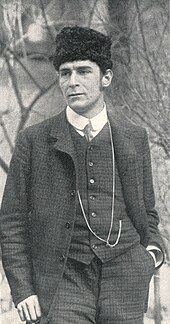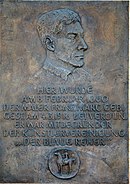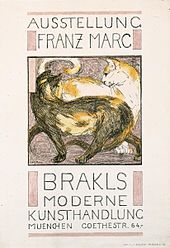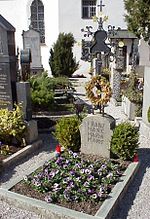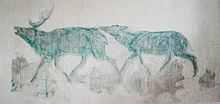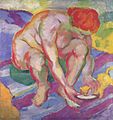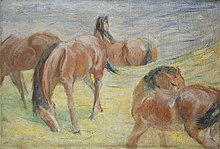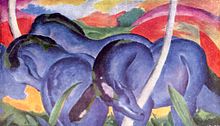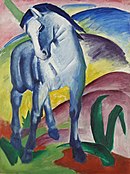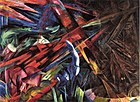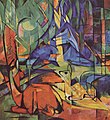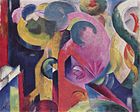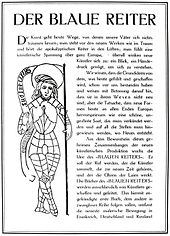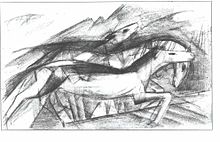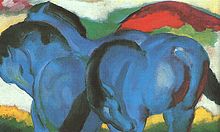Franz Marc
Franz Moritz Wilhelm Marc ( February 8, 1880 in Munich , † March 4, 1916 in Braquis near Verdun , France ) was a German painter , draftsman and graphic artist . He is considered one of the most important painters of Expressionism in Germany . Alongside Wassily Kandinsky , he was a co-founder of the editorial group Der Blaue Reiter , which opened its first exhibition in Munich on December 18, 1911. The Blue Rider came from the Neue Künstlervereinigung Munichemerged, in which Marc was briefly a member. For the almanac Der Blaue Reiter and other publications he wrote art- theoretical writings.
While Marc's early works were still in the naturalistic style of academicism , after a visit to Paris in 1907 he devoted himself to post-impressionism under the influence of Gauguin and van Gogh . Between 1910 and 1914 he used stylistic elements of Fauvism , Cubism , Futurism and Orphism , but did not completely separate from the subject in his work. During this time he created his well-known paintings, which mainly have animal motifs such as The Tiger , Blue Horse I , The Yellow Cow , The Tower of the Blue Horses or Animal Destinies . Marc's first abstract paintings, such as Small Composition I and Fighting Forms , were made in 1913 and 1914. He was drafted into the army at the beginning of World War I and died two years later at Verdun at the age of 36.
Life
childhood and school days
Franz Marc was born on February 8, 1880 as the second and last son of the Marc family at Schillerstraße 35 in Munich. His father Wilhelm Marc , who had first completed a law degree before taking up painting at the Academy of Fine Arts in Munich , was a landscape and genre painter . He came from a Bavarian family of civil servants. His mother Sophie , née Maurice, was from Alsace and had spent her childhood in French-speaking Switzerland, where she attended a strictly Calvinist boarding school. She had worked as a governess in the family of her future husband. Wilhelm and Sophie Marc had married late.

Franz and his brother Paul Marc , who was three years his senior , were baptized Catholics but brought up as Protestants. They grew up bilingual. Marc spent the summer of 1884 in Kochel am See for the first time , where the family stayed almost every summer for the next few years. Both brothers attended the Luitpold-Gymnasium in Munich, where Albert Einstein was a classmate for a time.
Father Wilhelm Marc left the Catholic Church and converted to the Protestant faith in 1895. Franz Marc was thinking of studying classical philology or theology like his older brother Paul – as he wrote in a letter in 1897 to Pastor Otto Schlier, whose confirmation classes had left a lasting impression on him. As an 18-year-old schoolboy, he studied literature and philosophy, particularly the work of Thomas Carlyle and Friedrich Nietzsche . In 1899 Franz Marc passed his Abitur at the Luitpold-Gymnasium.
Education

In 1899, Marc gave up the thought of a clerical profession and enrolled to study philology at the Ludwig-Maximilians-University in Munich . Before beginning his studies, in October of the same year he began his one-year military service in Lagerlechfeld near Augsburg and learned to ride. During this time he decided to follow his father's profession. In May 1901 he enrolled at the Munich Art Academy . He received instruction in anatomy from Gabriel von Hackl and in painting from Wilhelm von Diez , both of whom taught in the tradition of the 19th-century Munich school of painting. During the semester breaks of 1901 and 1902 he stayed at the Staffelalm in Jachenau , which was near the family's holiday resort in Kochel am See. In 1902 he occasionally conducted studies in the Dachauer Moos north of Munich .
In May 1903 he traveled through France with his friend Friedrich Lauer, who had sufficient funds at his disposal. A French-language diary has survived from this period. First they stopped in Paris for a few months , at the end of July they went to Brittany and then to Normandy . In Paris, Marc visited the Parisian museums, especially the antique collections, copied paintings in the Louvre and drew in the streets. He studied the sights and bought Japanese woodcuts in the art trade from Flammarion , whose technique and composition are said to have greatly impressed him. In the Notre-Dame-de-Chartres cathedral he was fascinated by the Gothic stained glass windows. After returning to Munich in early September of the same year, Marc left the art academy, disappointed by the academic teaching.
First studio and first marriage
In 1904 Marc moved out of his parents' house in Pasing and set up a studio at Kaulbachstraße 68 in Schwabing . During this time he had an affair with the art and antiquities connoisseur Annette Simon , née von Eckardt (1871–1934), wife of the Munich professor of Indology , Richard Simon (1865–1934), who was nine years his senior. As a painter, writer and copyist, she had good relationships with the art trade and antiquarians. She arranged for Marc, who was suffering from financial difficulties, to get commissions for prints and the opportunity to earn something by selling books, Japanese woodblock prints and other antiques from his collection.
In February 1905, Franz Marc met the art student Maria Franck at the farmers' church consecration ball, a costume party in Schwabing . Since she returned to Berlin shortly afterwards, they lost touch by December 1905. Towards the end of the year or in March 1906, Annette Simon von Eckardt separated from Franz Marc, but they remained friends for life.

To take his mind off the emotional strain, in April 1906 he traveled to Salonika and Mount Athos with his brother, who had become a Byzantine scholar and had a scholarly assignment to do in Greece . After this study trip, Franz Marc retired to work in Kochel, where he remained until the autumn. Both Maria Franck and another friend, the painter Marie Schnür , followed him. The three of them got involved in a love triangle , in which Marc increasingly turned to Schnür, who was eleven years his senior. Marie Schnür wanted to take care of her illegitimate son from the relationship with Angelo Jank (another source names August Gallinger as father) in Paris in February 1906, and Franz Marc gave her a promise of marriage, which he informed Maria Franck of in November 1906.
Franz Marc and Marie Schnür married on March 27, 1907 in Munich. On the same day he traveled alone to Paris, where he was particularly impressed by the works of Vincent van Gogh and Paul Gauguin . He summarized his enthusiasm for the local art and exhibition scene in reports that he sent to Maria Franck. The following year, on July 8, the marriage with Marie Schnür was divorced. However, since she accused Marc of adultery with Maria Franck, contrary to the agreements, Marc was initially unable to enter into a second marriage under current law.
Friendship with August Macke and Bernhard Koehler

In 1909, the Munich teaching materials store Wilhelm Plessmann commissioned Franz Marc to design weaving patterns for Plessmann 's handloom . The texts were written by his former lover Annette Simon-von Eckardt.
August Macke , whom he met in early 1910, visited him together with his cousin, the painter Helmuth Macke and Bernhard Koehler jun. (1882-1964), the son of his later patron Bernhard Koehler senior. , in his studio at Schellingstraße 33 in Munich. The reason for the visit were two of Marc's lithographs in Franz Josef Brakl 's Munich art dealership , which Macke had been enthusiastic about. For Marc it was the first contact with a like-minded artist. In 1912, a jointly created mural entitled Paradise was created in Macke's studio in Bonn . He was a lifelong friend of Macke, and Marc maintained a lively correspondence with him on questions of art theory .
Koehler Jr. had had some of Marc's pictures sent to his father through Brakl. Then Koehler sen. Marc in his studio at the end of January and bought the 1905 painting The Dead Sparrow that stood on Marc's desk, and which the artist was extremely reluctant to part with. The picture formed the cornerstone of Koehler's extensive Marc collection. As a result, he supported the artist, who was living on the poverty line, with 200 marks a month and in return received paintings of his choice, initially limited to one year.
In February 1910, Franz Marc had his first solo exhibition at the Brakl art dealership, which included 31 paintings as well as gouaches and lithographs. Two months later, Marc and Maria Franck moved to the house of the master carpenter Josef Niggl in Sindelsdorf , where they lived until 1914. Both gave up their studios in Munich. This house now has the address "Franz-Marc-Strasse 1".
In 1911, Marc refused a dispensation to marry Maria Franck, which is why both traveled to London at the beginning of June to enter into a marriage under English law, which, according to Maria Marc, they did not succeed in doing. From then on, they publicly referred to each other as a married couple.
Member of the New Artists' Association in Munich
In December 1909, Marc saw the first exhibition of the Neue Künstlervereinigung München (NKVM) several times in the Modern Gallery Heinrich Thannhauser in the Arco-Palais at Theatinerstraße 7. The second exhibition of the NKVM took place from September 1st to 14th, 1910, at which a total of 29 artists were involved. For example, works by Georges Braque , Pablo Picasso and Georges Rouault were on display . The exhibition - like that of 1909 - was attacked in the press and by the public, whereupon Marc, who had visited this exhibition, wrote a positive review, which reached the gallery owner Thannhauser via Reinhard Piper .
On January 1, 1911, Franz Marc met Wassily Kandinsky and Gabriele Münter in Marianne von Werefkin 's studio at Giselastrasse 23 , and the following day they attended an Arnold Schönberg concert in Munich , accompanied by Alexej von Jawlensky and Helmuth Macke . Under the impression of Schönberg's new music, Kandinsky painted the picture Impression III (Concert) shortly thereafter and wrote a letter to the unknown composer, thereby triggering a substantive discussion in which Kandinsky's "theses of the relationship of dissonances in art in the current Painting as in the musical composition by Schönberg […] were taken up and continued.” On February 4, 1911, Franz Marc was appointed third chairman of the NKVM. Marc presented his work and that of his girlfriend Maria Franck.
In the autumn of 1911, tensions between the conservative members and the group around Kandinsky intensified, as a result of which there was a scandal on December 2 with regard to the painting Composition V/The Last Judgment by Kandinsky, which the jury rejected because it was oversized. Wassily Kandinsky, Gabriele Münter, Franz Marc and Alfred Kubin resigned on the same day .
Editorial board member of the Blue Rider

After the editorial community of the Blue Rider founded by Kandinsky and Marc had formed as a secession from the NKVM , the "First Exhibition of the Editorial Team 'Der Blaue Reiter'" was opened in the Thannhauser Gallery on December 18, 1911. At the same time, the third exhibition of the remaining eight members of the NKVM was running on the floor above. 14 artists were represented at the first exhibition, alongside Marc and Kandinsky artists such as the Burljuk brothers , Heinrich Campendonk , Robert Delaunay , Jean-Bloé Niestlé , Elisabeth Epstein , August Macke , Gabriele Münter, Henri Rousseau and Arnold Schönberg . Franz Marc was represented, among other things, with his paintings Deer in the Forest I and The Yellow Cow ; both can be seen in a photo by Gabriele Münter, who photographically documented the exhibition.
The exhibition then went on tour to other cities, for example to the Gereonsklub in Cologne and to Herwarth Walden's Der Sturm gallery in Berlin . Further stations up to 1914 included Bremen, Hagen, Frankfurt, Hamburg, Budapest, Oslo, Helsinki, Trondheim and Gothenburg. The traveling exhibition also featured works by Jawlensky and Werefkin, who had meanwhile also left the NKVM and joined the Blue Rider.
The second exhibition of the Blue Rider followed from February 12 to March 18, 1912 under the programmatic title "Black and White" in the Munich book and art dealership Hans Goltz at Brienner Strasse 8. It showed only prints and drawings, under also works by Paul Klee and the Brücke artists. It was here that Franz Marc met Paul Klee for the first time, a meeting that led to a close friendship between the two artists.
In May 1912, Marc and Kandinsky, financially supported by Bernhard Koehler , published the almanac Der Blaue Reiter with a title woodcut by Kandinsky for Piper Verlag in Munich.
Sonderbund and First German Autumn Salon

In October 1912, Franz and Maria Marc visited the Macke couple in Bonn and saw the Sonderbund exhibition in Cologne. Shortly before the opening in the summer, there was a dispute between Marc and co-organizer Macke about the judging of some pictures. But meanwhile Marc was very impressed by the exhibition. His painting The Tiger was presented in the exhibition as picture no. 450. The friends decided to travel to Paris, where they met Robert Delaunay , who had exhibited at the Blaue Reiter, in person. His work, to which Guillaume Apollinaire had given the term Orphic Cubism and which, dominated by colour, led to "pure painting" and separation from the representational, impressed and shaped both painters. For Macke it was a "revelation", Marc merely adopted certain stylistic devices from Delaunay.
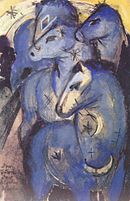
In December 1912, Marc met the poet Else Lasker-Schüler , divorced wife of Herwarth Walden , at his in-laws' home in Berlin . They soon became close friends, from which a lively exchange of letters between Prince Yussef of Thebes (Else Lasker-Schüler) and Franz Marc unfolded until the summer of 1914. In the years that followed, Marc sent her a total of 28 hand-painted postcards . The watercolor The Tower of the Blue Horses was a New Year's greeting for the year 1913 and is the only surviving colored draft for the oil painting of the same name, which has been missing since 1945 .

In the spring of 1913, Marc and Kandinsky planned to publish an illustrated Bible in which, with Kandinsky's approval, Alfred Kubin, Paul Klee, Erich Heckel and Oskar Kokoschka would be involved. Marc had chosen the Genesis chapter from Genesis. It was to be published by Piper Verlag as a Blaue Reiter edition. Negotiations for publication collapsed at the outbreak of World War I.
The civil marriage to Maria Franck took place on June 3, 1913. Marc reported the event to Kandinsky the day after: "I regret that I didn't give you and Klee the fun of doing our witnesses yesterday - they are playing a comedy at the Munich registry office that already exceeds the limits of what is permissible and imaginable ."
In the same year, Marc was instrumental in organizing the exhibition of Herwarth Walden's First German Autumn Salon , which took place in Berlin from September 1913. There, 90 artists from France, Germany, Russia, the Netherlands, Italy, Austria, Switzerland and the United States showed their works. The Delaunay couple, the co-organizers Marc, Macke and Kandinsky as well as other artists of the Blue Rider and the Futurists were strongly represented. Marc had included seven paintings in the exhibition, including The Tower of the Blue Horses , Tyrol and Animal Destinies , which Klee gave the title to.
Move to Ried and beginning of the war
At the beginning of 1914, Marc received an offer from Hugo Ball , at that time dramaturg at the Munich Kammerspiele , to direct William Shakespeare's The Tempest . But already on April 18, after critical newspaper reports, he gave up and wrote to Hugo Ball: "It would have to be said [...] that we want to reorganize the scene ourselves [...] and design it according to our artistic ideas."
At the end of April 1914, Marc acquired a villa in Ried near Benediktbeuern - which had belonged to Kochel am See since 1918 - in exchange for his parents' house in Pasing . With the financial support of his mother-in-law, he bought a piece of land to provide an enclosure for the deer that he had also bought. There was no further expansion of a studio; nevertheless, his last large paintings, some abstract , some representational, were created in Ried.
In August, Marc and Macke were called up for military service in the First World War . In earlier biographies they were referred to as war volunteers , but more recent publications contradict this claim. Marc's force was transferred to the French front at the end of the month. Like many artists and intellectuals of the time, both tended to exaggerate the outbreak of war as a "positive instance". Macke fell just two months later. His death hit Marc deeply, but initially did not change his attitude. In his obituary, which was not published until after the war, he expressed his sadness for his friend, but maintained his willingness to make sacrifices. In his "Letters from the Field" it becomes clear that he saw a sick Europe that had to be purified by war. A change of heart only set in later, as was the case with many other people, such as Max Beckmann . In October 1915, Marc wrote a letter to Lisbeth Macke , his friend's widow. In it he described the war as "the meanest manhunt we have surrendered to".
death
An application at the beginning of 1916 for "exemption" from military service, which was later rejected, remained meaningless: On March 4, 1916, Franz Marc was killed as a lieutenant in the Landwehr during a reconnaissance ride northwest of Braquis , almost 20 km east of Verdun . He had been hit in the head by shrapnel. The next morning, Franz Marc was buried under a simple memorial stone in the park of Gussainville Castle near Braquis. The art critic and journalist Max Osborn , as a war correspondent , described his chance visit to the resting place:
![]()
"This grave is freshly heaped up. Hard fenced. There is no cross on it yet, but a green wreath lies where the head of the Perfect One rests under the earth. […] A soldier sees me in front of the young hill. 'It just fell these days,' he said. ,Who is it?' – 'Marc was his name,' was the answer. 'He was a column leader.' It shivers through me. 'Marc?' I ask. 'Do you happen to know what else he was?' 'Yes, he was a painter!' 'And the first name Franz?' 'Yes, Franz.'”
In 1917 Maria Marc had his body transported to Kochel am See . A plaque commemorates him at the place where he died on the D108 between Braquis and Herméville-en-Woëvre . (Translation of the inscription: In this place, in the municipality of Braquis, the important German painter Franz Marc (1880–1916) was killed by a French shell on March 4, 1916)
“Now an artist has fallen who cannot fall. His kingdom is not of this world. But the earth was his home. The earth that creates life and sustains life. The earth seemed to him, the animals, the forests and the rocks spoke to him.”
plant
Franz Marc used techniques such as oil paints , gouaches , pencil , watercolor and created woodcuts . His preferred motifs were animals as symbols of originality and purity, since they embody the idea of creation and live in harmony with nature. With these pictures he expressed his utopia of a paradise world. The use of color in his works is not only expressive, but also symbolic, since Marc drew up his own color laws.
A total of 244 oil paintings are listed in Catalog Raisonné I , published by Beck . The continuing catalog raisonné II lists 261 drawings and watercolors, 94 postcards, 8 glass pictures, 17 handicraft designs on paper and 11 handicrafts, 9 embroideries and 15 sculptural works. Some works could not be attributed to Franz Marc by the art experts.
The artistic beginnings
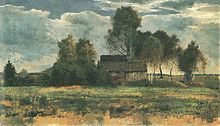
In 1901, Marc worked intensively, albeit in a withdrawn manner, in the painting class of the artist Wilhelm von Diez , who came from the Munich school and had developed a virtuoso, dark-toned history painting style. While works on paper from 1897 are known from the beginnings of Marc's work, oil paintings only date from 1902. The landscapes that were created in the summer of 1902 on the Staffelalm above Kochel am See and in the Dachauer Moos are characterized by naturalism . An example of his traditional painting is the painting Moorhütten im Dachauer Moos from 1902, which - meticulously painted - is dominated by dark brown and green tones.
In the forefront of Expressionism
Between 1904 and 1907, Marc was looking for his own style. In a cycle of illustrations for a volume with texts by poets such as Richard Dehmel , Carmen Sylva and Hans Bethge , he dealt with Art Nouveau . The book was published in an edition of 110 copies under the title Stella Peregrina posthumously in 1917 by the Franz Hanfstaengl publishing house in Munich. Annette Simon-von Eckardt had hand-colored 18 of Marc's facsimile illustrations from this period, the introduction was by Hermann Bahr .
In 1905 Marc became friends with the young Swiss animal painter Jean-Bloé Niestlé . This encouraged him to implement the fondness for animals in such a way that they could not be depicted as zoological representations; rather, the artist should put himself in the place of the animal and capture its essence in the painting. Meeting Niestlé gave Marc the impetus to further develop animal painting as a means of artistic expression. In the same year, the first example was Der tote Sparrow .
He spent the summer of 1905 withdrawn back to the Staffelalm, where he painted pictures in a less colored style in the traditional way with light and shadow. In that year he came into contact with the artists of the Scholle through Marie Schnür, whose painters practiced a variant of Art Nouveau painting in the wake of Impressionism . In the autumn he met Adolf Hölzel in Dachau , the co-founder of the artists' colony in Dachau , which at the time cultivated plein-air painting, from which Marc was not to break free until December 1910.
Franz Marc and Maria Franck spent the summer of 1908 intensively painting in Lenggries . The impression made on him by van Gogh's art was reinforced in December 1909 by an exhibition at the Kunsthaus Brakl in Munich, where he helped hang the seven paintings on display. He grappled with van Gogh's formal language, and the result is documented in the painting Cats on Red Cloth , created between December 1909 and early January 1910 . During a visit to Berlin in May 1910, he saw works by the Fauvist painters Henri Matisse and Kees van Dongen and subsequently explored the Fauvist style in the painting Nude with Cat . His mistress Maria Franck served as a model for the painting .
Indersdorf , 1904, City Gallery in the Lenbachhaus , Munich
Elephant , 1907, Hamburger Kunsthalle
animalization of art
From 1910, after moving to Sindelsdorf, Marc, for whom the animal increasingly became a metaphor for creaturely purity and innocence, concentrated on the image of animals in the rural seclusion. After naturalistic beginnings and experiences with Impressionism, he came a few steps closer to his goal of "animalizing art" in his paintings and sculptures around 1909. In an essay for the book Das Tier in der Kunst , published by Reinhard Piper in 1910 , Marc describes:
- "I try to increase my sense of the organic rhythm of all things, try to empathize pantheistically with the trembling and trickling of blood in nature, in trees, in animals, in the air."

In this phase, Marc tried to achieve "animalization", the bringing to life of his pictures, through vibrations and parallelism of the lines, whereby the inner, the organic life of the animals became visible in their harmonious connection with the environment. For several years, the motifs for this have been the rhythmically arranged groups of horses on the pasture, as shown in his Grazing Horses I , which are still kept in naturalistic colours . In 1909, Jakob Johann von Uexküll already dealt in detail with the “inner life” of animals in his publication Environment and Inner World of Animals , which the well-read Franz Marc may have already taken note of at the time. For Marc, this led to the question of how a horse, an eagle, a deer or a dog sees the world, leading to a self-critical reassessment of his own conventions - "putting the animals in a landscape that belongs to our eyes, not to us to immerse oneself in the soul of the animal in order to guess its pictorial circle".
For example, the painting Dog Lying in the Snow , a depiction of Marc's Siberian shepherd Russi, exudes complete harmony in the coexistence of animals and nature; it reflects the oneness between the nature around him, the resting of the snow and the resting of the dog on it - "a common stillness of animate and inanimate nature."
Color scheme in Marc's work

In 1910, Marc was still struggling to "get out of the randomness of the color" and confessed on December 6th of that year: "[...] but to do that you have to know a lot more about the color and not fiddle around with the lighting so haphazardly". Two days later he recalled a conversation in which Marianne von Werefkin explained to Helmuth Macke that “almost all Germans make the mistake of taking light for color, while color is something completely different and associated with light, i. H. Lighting, has nothing to do with lighting at all.” Inspired by this remark, Marc began to deal with the color theory of Johann Wolfgang von Goethe and Wilhelm von Bezold as well as with the color symbolism of Philipp Otto Runge , with Adolf Erbslöh helping him out with a “small edition of the Chevreul ” . .
In lively correspondence with August Macke , he described in detail his findings and the intention to create his own color theory from them. He formulated it in a letter to Macke dated December 12, 1910:
“Blue is the male principle, austere and spiritual. Yellow the feminine principle, soft, cheerful and sensual. Red matter, brutal and heavy and always the color that must be fought and overcome by the other two! Do you mix z. E.g. the serious, spiritual blue with red, then you increase the blue to the point of unbearable sadness, and the reconciling yellow, the complementary color to violet, becomes indispensable. […] If you mix red and yellow to make orange, you give the passive and feminine yellow a multi-layered, sensuous power, so that the cool, spiritual blue again becomes indispensable, man, and the blue immediately and automatically places itself next to orange, the colors love each other. Blue and orange, a thoroughly festive sound. But if you now mix blue and yellow to make green, you bring red, matter, the earth, to life.”
Beginning of abstraction
In 1911 he created the paintings Blue Horse I (Municipal Gallery in the Lenbachhaus, Munich) and Blue Horse II ( Bern Art Museum ). In them, Marc turns blue from an "appearing color" into an "essential color". With the animal image he found a symbol for a “spiritualization of the world”. Like the blue flower of romanticism , the blue horse expresses the search for redemption from earthly heaviness and material bondage. In contrast to the blue, Marc realized his idea of yellow as "the feminine principle, gentle, serene, sensual" in the painting The Yellow Cow , also from 1911, which expresses joie de vivre. The tiger from 1912 has a cubist design vocabulary that Marc had become acquainted with in the paintings of Pablo Picasso and Georges Braque at the second NKVM exhibition . He transformed them expressively.


The paintings, made until 1914, approach a "prismatic" and "crystalline" abstraction , resulting from a fusion of the forms of Italian Futurism and Robert Delaunay 's Orphism . Examples of this are the non-representational Small Compositions , which were created in four motifs between the end of 1913 and the beginning of 1914.
The horse bodies on the work The Tower of the Blue Horses from 1913, which has been missing since 1945 , already appear abstract, composed of geometric shapes, and the landscape background consists only of abstract formations. His abstract painting style is even more evident in the painting Animal Destinies from the same year, in which horses, pigs and wolves appear vaguely between pointed, menacing-looking forms and in the center a blue-and-white deer can be seen that stretches its head extremely upwards. On the back of the picture, Marc noted: "And all being is flaming suffering"; In a letter to his wife in 1915, he interpreted this text as a premonition of war.
Four non-representational works created in Ried date from 1914, the paintings Cheerful Forms , Playing Forms , Fighting Forms and Broken Forms . The titles show the ambiguity of his feelings. One interpretation of the Fighting Forms compares the red area on the left with an eagle pouncing on an unspecified dark being. Tirol , on which a Madonna can be seen, is more representational than the forms . The last painting is Deer in the Forest II , which shows three deer in a forest clearing in a highly abstract form. The animal had lost its importance for him; in a letter from the field to his wife dated April 12, 1915, Marc wrote:
“I found people to be 'ugly' very early on; the animal seemed prettier, purer to me; but I also discovered so much that was anti-emotional and ugly in him, so that my depictions [...] instinctively became more and more schematic, more abstract.”
The Tower of the Blue Horses , 1913, lost
Animal Destinies , 1913, Kunstmuseum Basel
Deer in the forest II , 1914, Kunsthalle Karlsruhe
Small Composition III , 1914, Osthaus Museum Hagen
writings
1910-1912
In 1910 Reinhard Piper published Marc's essay Über das Tier in der Kunst in his publishing house . Marc wrote to the publisher:
"'My aims are not in the line of special animal painting. I'm looking for a good, pure and light style, in which at least a part of what modern painters have to say to me can be completely absorbed'. Excerpts of further art-theoretical writings such as The constructive ideas of new painting from March 1912 can be reached via the following footnote.”
In the summer of 1911, the book Im Kampf um die Kunst was published by Piper Verlag, in which Kandinsky and Marc, along with other artists, gallery directors and writers, wrote articles in response to Carl Vinnen 's polemical book A Protest by German Artists . On the occasion of the purchase of a van Gogh painting by the director of the Kunsthalle Bremen, Gustav Pauli , in April 1911, Vinnen spoke out against the “foreign infiltration of German art”, and in his appeal he won the signatures of Thomas Theodor Heine , Franz by Stuck and Käthe Kollwitz . The controversy became known as the Bremen artists' dispute .
In March 1912, the art magazine Pan Marcs published an article about "The New Painting", in which he wanted to prove that his painting, which he described as "new", was not due to Impressionism , but at most, and then only to a limited extent, to Paul Cézanne . Every era has its quality and the artistic value or disvalue of the new pictorial ideas must be discussed. Max Beckmann , who had assisted Marc in Im Kampf um die Kunst , criticized Marc's remarks in the following pan by placing the works of Gauguin , Matisse and Picasso in the vicinity of applied art and concluding with the sentence: "The laws of Art is eternal and immortal, like the moral law within us". Marc answered in a pan , but two points of view collided, which are still being fought out in the present.
Almanac Der Blaue Reiter 1912
In May 1912 the almanac Der Blaue Reiter was published with a dedication to Hugo von Tschudi in an edition of 1200 copies, which Kandinsky concluded with three long articles. At the request of the publisher Piper, the word “Almanac” had to be removed from the title woodcut by Kandinsky before it went to press. The work did not become an annual publication as originally planned, but was only reprinted in 1914. 141 picture reproductions, 19 text contributions and three music supplements were listed in the book. Marc was represented with illustrations of his paintings and with three short introductory chapters.
In Spiritual Goods he complained that intellectual goods were valued less than material goods. In the second article, Die "Wilden" Deutschlands , he explained that the modern artists - the "Wilden", based on the Fauves - of the Brücke , the Neue Secession in Berlin and the Neue Künstlervereinigung Munich consistently went the way of spiritual renewal of art :
“The most beautiful prismatic colors and the famous cubism have become meaningless as the goal of the 'savages'. Their thinking has another goal: to create symbols through their work of their time that belong on the altars of the coming spiritual religion and behind which the technical producer disappears.”
In the last chapter Two Pictures , Marc juxtaposed an illustration from Grimm's Fairy Tales from 1832 with the painting Lyric by Kandinsky from 1911. Both pictures are "of the same deep inwardness of artistic expression". The authors, alongside the two editors Marc and Kandinsky as well as Delaunay, Macke and Schönberg, provided texts and image examples from various fields of fine arts, folk art, music and theatre. The almanac by artists for artists became one of the most important German-language programmatic writings for 20th-century art; it was published in all world languages.
1913-1916
For the First German Autumn Salon in September 1913, Marc wrote a foreword for the catalogue , alongside Herwarth Walden's foreword, on behalf of his exhibiting artist colleagues .
Franz Marc's first war publication appeared in the Vossische Zeitung on December 15, 1914, entitled Im Purgatory of War ; he had written it in October of the same year during a stay in the hospital due to dysentery . The following year, his second pamphlet was published under the title Secret Europe . In it: “The war goes around. Europe is sick with the old hereditary disease and wants to get well, that’s why it wants the terrible bloodshed […] The war is waged for cleansing and the sick blood is spilled.”
Marc's letters from the field and his sketchbook, the only pictorial expression from the war, were published in 1920 by Paul Cassirer in Berlin under the title Franz Marc, letters, notes and aphorisms .
Contemporaries about Franz Marc
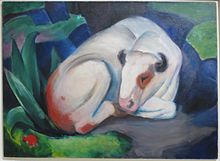
In his contribution On the Form Question in the Almanac , Kandinsky emphasized Marc's importance for abstract art based on the painting The Bull depicted there and emphasized the "strong abstract ringing of the physical form", which does not demand the destruction of the representational, but rather "its individual ones parts" into an "overall abstract main sound".
Paul Klee wrote in his diary in 1916 in memory of Franz Marc: "When I say who Franz Marc is, I must also confess who I am, because much of what I take part in also belongs to him. He is more human, he loves warmer, more outspoken. To the animals he inclines humanely. He exalts them to himself.”
The poet Else Lasker-Schüler published an obituary in the Berliner Tageblatt on March 9, 1916 , beginning with the lines: “The blue rider has fallen, a great biblical figure on whom the scent of Eden hung. He cast a blue shadow across the landscape. He was the one who still heard the animals talking; and he transfigured their misunderstood souls". She published another obituary the following year: When the blue rider had fallen … , a poem that owed its origin to the supposed loss of the painting Tierschicksale , which had been badly damaged in a fire in 1917. Her novel Der Malik , dedicated to Franz Marc, was published in 1919 . An emperor's story with pictures and drawings in the Paul Cassirer publishing house in Berlin.
In a letter to Marie-Anne von Goldschmidt-Rothschild in autumn 1916, after a visit to the Munich memorial exhibition, Rainer Maria Rilke noted that he had "finally seen an oeuvre again", "a unity of life achieved and achieved in the work".
public perception
First posthumous exhibitions
From September 14 to October 15, 1916, half a year after Marc's death, the "Franz Marc Memorial Exhibition" was shown in Munich's Neue Secession - the exhibition building of the artist group formed in 1913. This was followed in November by the memorial exhibition at Herwarth Walden's Sturm-Galerie in Berlin, which featured almost 200 of the artist's works, including the fates of animals . During interim storage, the painting was partially destroyed by fire in 1917 and restored by Paul Klee in 1919. His works were exhibited at the 16th Venice Biennale in 1928.
time of the nationalsocialism
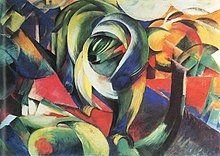
During the National Socialist era , the art world had a grace period until the end of the Olympic Games in the summer of 1936. On the 20th anniversary of Franz Marc's death, the Kestner Society in Hanover held a commemorative exhibition from March 4 to April 14, 1936, in which 165 works by the artist were shown. They were part of Marc's first catalog raisonné, which the art historian Alois Schardt wrote together with his wife and Marc's widow, Maria Marc, and published in Berlin in 1936. It contains a total of 996 works. After Hanover, she was on view from May 4th at the galleries in Nierendorf and von der Heyde in Berlin. The introductory lecture by Alois Schardt on the evening before the opening was banned by the Gestapo , Schardt was arrested and his book about Marc, which had just appeared, was confiscated. The 1911 painting The Little Blue Horses featured in both memorial exhibitions and now hangs in the Staatsgalerie Stuttgart . The picture belonged to the art collector and patron Alfred Hess and , as with some of Marc's other pictures, ownership has not yet been finally clarified.
In 1936/37, 130 works by Franz Marc were confiscated from German collections. A total of 650 works by various artists from 32 German museums were exhibited from July 19, 1937 at the same time as the Great German Art Exhibition in the newly opened House of German Art in the nearby gallery building at the Hofgarten in the exhibition "Degenerate Art" . Six paintings by Marc were shown. Even before the works were sold abroad, Hermann Göring selected 13 paintings for his collection, including Deer in the Forest and The Tower of the Blue Horses . Both pictures have been missing since 1945.
After the Second World War
After the Second World War , Franz Marc's paintings began to become popular, and the animal paintings from 1911/12 soon hung in many homes as art copies. Some of his works were shown at documenta 1 (1955), documenta II (1959) and documenta III in 1964 in Kassel . However, the importance of the artist as one of the pioneers of abstract art in his later works only became apparent from 1976 through the monograph by Klaus Lankheit and the 1980 memorial exhibition in Munich's Lenbachhaus . A solo exhibition took place there from August to October 1963.

A retrospective of Franz Marc's paintings and graphics, the largest after the general exhibition in 1916, was opened on September 17, 2005 in the Lenbachhaus and in the associated art building. By January 8, 2006, it reached a record number of around 300,000 visitors.

The Blue Year – 100 Years of the Blue Rider , under this comprehensive title, the Franz Marc Museum in Kochel offered not only collection presentations but also special exhibitions by Ernst Ludwig Kirchner and Paul Klee as well as, from September 18, 2011, Franz Marc and Joseph Beuys . In harmony with nature . The exhibition, which was then on view from December 8, 2011 to February 12, 2012 in the Sinclair House of the Altana Cultural Foundation in Bad Homburg, made it clear that Joseph Beuys and Franz Marc are shaped by their closeness to nature in their thinking and work and their works reflect common starting points of a concept of nature rooted in the tradition of German Romanticism . Just as Marc's horse or deer became a symbol of the spiritual, Beuys' deer, swan, bee and rabbit are symbolic bearers of their own mythology, grown out of Christian, literary and scientific contexts and charged with social relevance.

Also in the Blue Year , the Murnau Castle Museum pointed out the influence of Japanese art on the Blue Rider artists for the first time in the exhibition The Painters of the Blue Rider and Japan , which ran from July 21 to November 6, 2011 . Pieces from the painters’ collection, including Franz Marc’s Japanese art collection, as well as examples of works made up the spectrum of the exhibition, which established the connection to “classical Japonism ”.
In the summer of 2013, a study of two cats, probably also painted by Marc in 1913, was discovered under the painting The Blue Foals from 1913. It was shown in the Kunsthalle in Emden from October 3rd of that year.
On November 5, 2013, a study of the Great Blue Horses from 1911 entitled Horses in Landscape , owned by art dealer Hildebrand Gurlitt , was shown at a televised press conference on the spectacular Schwabing art find . The former owner was the Moritzburg Art and Trade Museum in Halle (Saale) .
estate
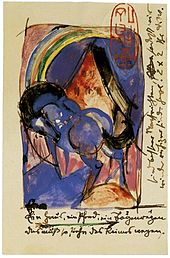
In 1949 Maria Marc asked the gallery owner Otto Stangl to manage her husband's artistic estate. After the death of Maria Marc on January 25, 1955, Stangl became "custodian of the Franz Marc legacy"; according to the widow's legacy, he donated a certain number of paintings to some important museums.
The written estate of Franz Marc was purchased in 1973 by the German Art Archive in the German National Museum in Nuremberg from the Stangl Gallery in Munich. 200 documents were added as a gift from a Stangl heir in 2005.
The Franz Marc Museum , founded in 1986 and expanded in 2008, is located in Kochel am See . When the Franz Marc Museum was founded, the estate administrator Otto Stangl already had the vision of later expanding it in order to make the continuation of the idea of “spiritual in art”, which was important to the Blaue Reiter, understandable through post-war abstraction. The Etta and Otto Stangl Foundation bequeathed many works to the museum, including paintings by his artist friends who were associated with the Blue Rider. The different influences on Franz Marc's art as well as the suggestions that emanated from her are presented with examples of work in the Franz Marc Museum.
The collection of Japanese color woodcuts that Franz Marc acquired in Paris in 1903 is not complete. In 2009, 21 ink drawings and woodcuts as well as 17 illustrated books from his estate came to the Murnau Castle Museum . Since 1908, Marc had his name or monogram cut into at least three Chinese and Japanese soapstones in the East Asian style, in order to use them as stamps on postcards and letters.
The Germanisches Nationalmuseum in Nuremberg has 26 of a total of 32 sketchbooks from the years 1903 to 1914. They were acquired from the estate in 1982 and exhibited in a special exhibition from May 23 to September 1, 2019.
appreciations
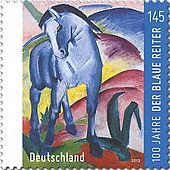

Franz Marc received increased public attention, especially in the last third of the 20th century.
Streets are named after Marc in several cities in Germany, for example in Fulda , Fürth , Hamburg , Landshut , Wolfsburg , Oldenburg , Puchheim , Vechta , Elmshorn , Heidelberg , Kochel am See , Cologne , Kösching , Leverkusen , Mühlheim , Saarbrücken , Schifferstadt , Schweinfurt , Sindelsdorf , Toging and Munich .
On October 13, 2000, an asteroid discovered in 1991 was named after him: (15282) Franzmarc .
On February 15, 1974, the Deutsche Bundespost issued a stamp with the red deer worth 30 pfennigs as part of a double issue on German Expressionism, with the second stamp for 40 pfennigs showing Alexej von Jawlensky 's head in blue . On June 11, 1992, as part of the series “ German Paintings of the 20th Century ”, the Deutsche Bundespost issued a 60-pfennig commemorative stamp with the motif of a horse in a landscape . On the occasion of the 100th anniversary of the Blue Rider , Deutsche Post AG issued a special stamp worth 145 euro cents. The day of issue was February 9th, 2012. The design was created by the communication designer Nina Clausing from Wuppertal and is based on the work Blue Horse I from 1911 by Franz Marc.
The Franz Marc Museum , opened in 1986, was dedicated to the artist. Three years later, in 1989, the former Markt Schwaben high school was renamed Franz-Marc-Gymnasium in honor of the artist . His bust is on display in the Munich Hall of Fame.
The Free State of Bavaria celebrated two anniversaries in 2011, the 125th anniversary of the death of the "fairy tale king" Ludwig II and at the same time the 100th birthday of the Blue Rider . Many exhibitions in museums showed the works of the participating artists in special shows, for example the Murnau Castle Museum , the Franz Marc Museum, the Buchheim Museum in Bernried and the Penzberg City Museum . In 2014, on the occasion of the 100th anniversary of the death of Franz Marc's artist friend August Macke , the Kunstmuseum Bonn opened the exhibition "August Macke and Franz Marc. An Artist Friendship”. For the first time, she presented around 200 works that relate exclusively to the friendship between the two artists and their art. From January to May 2015 it was shown in Munich's Lenbachhaus. On the 100th anniversary of the artist's death on March 4, 2016, the Franz Marc Museum dedicated an exhibition trilogy to him under the collective title "Franz Marc - Between Utopia and Apocalypse", the third part of which ended in January 2017.
Franz Marc on the art market
In February 2008, the auction of Grazing Horses III from 1910 at Sotheby's in London reached a record price of the equivalent of 16.5 million euros. That was double the estimate. The bidder remained unknown.
In June 2009, one of Marc's last Impressionist paintings, Prancing Horses , also from 1910, fetched the equivalent of 4.4 million euros at an auction at Christie's in London. It was just below the estimate.
Franz Marc's Drei Pferde from 1912, a small gouache on cardboard, fetched four times its estimate, also at Christie's in 2018. With buyer's premium it reached 15.4 million pounds, just under 17.5 million euros.
Selected Works




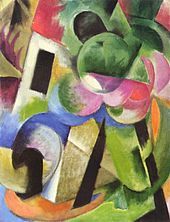

painting
- 1902: Portrait of the Mother , oil on canvas, 98.5 × 70 cm, Städtische Galerie im Lenbachhaus , Munich
- 1902: Portrait of the Father , oil on cardboard, 73 × 50.8 cm, Städtische Galerie im Lenbachhaus, Munich
- 1902: Moor huts in the Dachauer Moos , oil on canvas, 43.5 × 73.6 cm, Franz Marc Museum , Kochel
- 1904: Indersdorf , oil on canvas, 40 × 31.5 cm, Städtische Galerie im Lenbachhaus, Munich
- 1905: The Dead Sparrow , oil on panel, 13 × 16.5 cm, private collection
- 1905: Small Horse Study II , oil on cardboard, 27 × 31 cm, Franz Marc Museum, Kochel
- 1906: Two women on the mountain , sketch, oil on canvas laid down on cardboard, 15.5 × 24.7 cm, Franz Marc Museum, Kochel
- 1907: Woman in the Wind by the Sea , oil on cardboard, 26 × 16 cm, Franz Marc Museum, Kochel
- 1908: Little Larch Trees , oil on canvas, 100 × 71 cm, Museum Ludwig , Cologne
- 1908: Leaping Dog , oil on canvas, 54.5 × 67.5 cm, Städtische Galerie im Lenbachhaus. Munich
- 1909: Small horse picture , oil on canvas, 16 × 25 cm, Franz Marc Museum, Kochel
- 1909: Deer at dusk , oil on canvas, 100 × 70 cm, Städtische Galerie im Lenbachhaus, Munich
- 1909/10: Cats on Red Cloth , oil on canvas, 50.5 × 60.5 cm, private collection
- 1910: Horse in the Landscape , oil on canvas, 85 × 112 cm, Museum Folkwang , Essen
- 1910: Nude with Cat , oil on canvas, 86.5 × 80 cm, Städtische Galerie im Lenbachhaus, Munich
- 1910: Grazing Horses I , oil on canvas, relined, 64 × 94 cm, Städtische Galerie im Lenbachhaus, Munich
- 1910: Red Deer I , oil on canvas, 87.6 × 88.3 cm, private collection
- 1911: The Little Blue Horses , oil on canvas, 61 × 101 cm, Staatsgalerie , Stuttgart ,
- 1911: The Bull , oil on canvas, 135 × 101 cm, Solomon R. Guggenheim Museum , New York
- 1911: Blue Horse I , oil on canvas, 112.5 × 84.5 cm, Städtische Galerie im Lenbachhaus, Munich
- 1911: Dog Lying in the Snow , oil on canvas, 62.5 × 105 cm, Städelsches Kunstinstitut , Frankfurt am Main
- 1911: The Great Blue Horses , oil on canvas, 181 × 105 cm, Walker Art Center , Minneapolis / Minnesota
- 1911: The Red Horses , oil on canvas, 121 × 183 cm, Busch-Reisinger Museum , Cambridge / Massachusetts
- 1911: Deer in the Snow , oil on canvas, 84.7 × 84.5 cm, Städtische Galerie im Lenbachhaus, Munich
- 1911: Portrait of Henri Rousseau , picture behind glass, 15.3 × 11.4 cm, Städtische Galerie im Lenbachhaus, Munich
- 1911: The Yellow Cow , oil on canvas, 140.7 × 189.2 cm, Solomon R. Guggenheim Museum , New York
- 1911: Crouching in the Snow , oil on canvas, 79.5 × 100 cm, Franz Marc Museum, Kochel
- 1911: Fox , oil on canvas, 50 × 63.5 cm, Von der Heydt Museum , Wuppertal
- 1912: Little Yellow Horses , oil on canvas, 104 × 66 cm, Staatsgalerie Stuttgart, Stuttgart
- 1912: The Tiger , oil on canvas, 111 × 111 cm, Städtische Galerie im Lenbachhaus, Munich
- 1912: Two Cats, Blue and Yellow , oil on canvas, 74 × 98 cm, Kunstmuseum Basel , Basel
- 1912: In the Rain , oil on canvas, 81.5 × 106 cm, Städtische Galerie im Lenbachhaus, Munich
- 1912: Red Deer II , oil on canvas, 70 × 100 cm, Pinakothek der Moderne , Munich
- 1912: Pigs , oil on canvas, 83 × 58 cm, private collection
- 1912: Sheep , oil on canvas, 76 × 49 cm, Saarlandmuseum , Saarbrücken
- 1912: The little monkey , oil on canvas, 70.4 × 100 cm, Städtische Galerie im Lenbachhaus, Munich
- 1912: Deer in the monastery garden , oil on canvas, 75.7 × 101 cm, Städtische Galerie im Lenbachhaus, Munich
- 1912: In the Rain , 1912. Oil on canvas 81 × 105.5cm. City gallery in the Lenbachhaus
- 1912: The Blue Little Horse , oil on canvas, 58 × 73 cm, Modern Gallery , Saarbrücken
- 1913: The Enchanted Mill , oil on canvas, 130.6 × 90.8 cm, Art Institute of Chicago , Chicago
- 1913: Animal Destinies , oil on canvas, 195 × 263.5 cm, Kunstmuseum Basel, Basel
- 1913: Foxes , oil on canvas, 87 × 65 cm, Museum Kunstpalast , Düsseldorf, September 2021 Restitution
- 1913: The Mandrill , oil on canvas, 91 × 131 cm, Pinakothek der Moderne, Munich
- 1913: Three Cats , oil on canvas, 72 × 102 cm, Kunstsammlung Nordrhein-Westfalen , Düsseldorf
- 1913: Picture with Cattle , oil on canvas, 92 × 130.8 cm, Pinakothek der Moderne, Munich
- 1913: Sleeping Horse , watercolor and ink on paper, 46 × 40 cm
- 1913: Deer in the Woods I , oil on canvas, 100.5 × 104 cm, Phillips Collection , Washington
- 1913: The Tower of the Blue Horses , oil on canvas, 200 × 130 cm, lost since the end of the war in 1945, is considered Marc's most important work
- 1913: The Blue Foals , oil on canvas, 55.7 × 38.5 cm, Kunsthalle in Emden , Emden
- 1913: Small Composition I , oil on canvas, 46.5 × 41.5 cm, private collection
- 1913: Wild Boars , oil on cardboard, 73.5 × 57.5 cm, Museum Ludwig , Cologne
- 1914: Landscape with House, Dog and Cattle , oil on canvas, private collection
- 1914: Cheerful Forms , oil on canvas, destroyed in the war
- 1914: Playing Forms , oil on canvas, 56.5 × 170 cm, private collection
- 1914: Fighting Forms , oil on canvas, 131 × 91 cm, Pinakothek der Moderne, Munich
- 1914: Broken Forms , oil on canvas, 112 × 84.5 cm, Solomon R. Guggenheim Museum, New York
- 1914: Small Composition II , oil on canvas, 59.5 × 46 cm, Sprengel Museum, Hanover
- 1914: Small Composition III , oil on canvas, 46.5 × 58 cm, Osthaus Museum , Hagen
- 1914: Little Composition IV , Franz Marc Museum, Kochel
- 1914: Tirol , oil on canvas, 135.7 × 144.5 cm, Pinakothek der Moderne, Munich
- 1914: Deer in the Forest II , oil on canvas, 110 × 100.5 cm, Staatliche Kunsthalle , Karlsruhe
drawings
- 1906: Seated farmer's wife with a chicken in her lap , colored chalk, Murnau Castle Museum
- 1907: Elephant , chalk, 41.5 × 33.8 cm, Hamburger Kunsthalle , Hamburg
printmaking


- 1911/12: Resting Horses , woodcut, 25.5 × 38.2 cm, Albertina , Vienna
- 1912: Reconciliation , woodcut, published in: Der Sturm , 3rd year, number 125/126
- 1912: Sleeping Shepherdess , woodcut, 19.7 × 24 cm, British Museum , London
- 1913: Birth of the Horses , woodcut, 21.5 × 14.5 cm, State Graphic Collection, Munich
- 1913: Birth of the wolves , woodcut, 25.3 × 18.5 cm, Moritzburg Art Museum Foundation of the State of Saxony-Anhalt, Kracht Collection
- 1914: Creation Story I (The Baboon) , woodcut, 24 × 20 cm, Moritzburg Art Museum Foundation of the State of Saxony-Anhalt, Kracht Collection
- 1914: Creation Story II , color woodcut, 23.7 × 20 cm, Moritzburg Art Museum Foundation of the State of Saxony-Anhalt, Kracht Collection
sculptures
- 1908: The Panther , bronze, height 9.5 cm, Städtische Galerie im Lenbachhaus, Munich
- 1908: Horse , bronze, height 16.4 cm, partial cast from a double group, Franz Marc Foundation Collection
- 1908/09: Two horses , bronze, height 16.2 cm, Moritzburg Foundation, Art Museum of the State of Saxony-Anhalt , Kracht Collection
Literature (selection)
Writings and catalogs of works
general directories
- Franz Marc: Works, letters and writings , Directmedia Publishing GmbH, Berlin 2007, Digital Library Volume 155 (CD-ROM edition), ISBN 978-3-89853-555-7
The blue Rider
- Klaus Lankheit : Der Blaue Reiter, Edited by Wassily Kandinsky and Franz Marc. Documentary new edition. Munich/Zurich 1984.
- Wassily Kandinsky, Franz Marc: The Blue Rider. Documentary re-edition . Piper, Munich 2004, ISBN 978-3-492-24121-2 .
- Yasmin Doosry (ed.): Franz Marc on the way to the »Blauer Reiter«. The sketchbooks in the Germanisches Nationalmuseum . Nuremberg 2019, ISBN 978-3-946217-21-3 .
Correspondence, writings and documents
- Cathrin Klingsöhr-Leroy : Between the lines - documents on Franz Marc. Hatje, Ostfildern, 2005, ISBN 3-7757-1595-9 .
- Klaus Lankheit (ed.): Franz Marc. writings . DuMont, Cologne 1978, ISBN 3-7701-1088-9 .
- Klaus Lankheit (ed.) Wassily Kandinsky. Franz Marc. correspondence. With letters from and to Gabriele Münter and Maria Marc . Piper, Munich 1983, ISBN 3-492-02847-0 .
- Else Lasker-Schüler, Franz Marc: My dear, wonderful blue rider. Private Correspondence . Edited by Ulrike Marquardt. Artemis & Winkler, Düsseldorf 1998, ISBN 3-538-06820-8 .
- Wolfgang Macke (ed.): August Macke. Franz Marc. Correspondence , DuMont Schauberg, Cologne 1964
- Franz Marc: Letters from the field . First published 1920. Piper, Munich 2000, ISBN 978-3-492-10233-9 .
- Franz Marc: Letters from the field . 1914-1916. With an introduction by Cathrin Klingsöhr-Leroy. Allitera, Munich 2014, ISBN 978-3-86906-621-9 .
- Franz Marc: the sketchbook from the field - the graphic work. Published on the occasion of the exhibition in the Kunstmuseum Bern April 8 to May 15, 1967. Kunstmuseum Bern 1967
- Günter Meißner (ed.): Franz Marc, letters, writings and records. Leipzig and Weimar 1980
- Peter-Klaus Schuster: Franz Marc, Else Lasker-Schüler, The Blue Rider presents His Blue Horse to Your Highness, cards and letters. Munich 1987
- Bernd Fäthke: Marianne Werefkin - "the blue rider rider" . In: Marianne Werefkin, Vom Blauen Reiter zum Großer Bären , exhibition catalogue, Städtische Galerie Bietigheim-Bissingen 2014, ISBN 978-3-927877-82-5 (on page 24 there is a previously unknown letter from Maria Marc; on pages 55 ff. a previously unknown correspondence between Marc and Werefkin can be found.)
- Maria Marc/Brigitte Roßbeck (ed.): Sometimes my heart threatens to burst. My life with Franz Marc. Siedler Verlag, Munich 2016, ISBN 978-3-8275-0035-9
catalog raisonné
- Alois Schardt : Franz Marc . Rembrandt-Verlag, Berlin 1936, pp. 161-175 catalog raisonné
- Annegret Hoberg , Isabelle Jansen: Franz Marc. Catalog raisonné, vol. I, paintings . Beck, Munich 2003, ISBN 3-406-51142-2 .
- Annegret Hoberg, Isabelle Jansen: Franz Marc. Catalog raisonné, vol. II, watercolours, gouaches, drawings, postcards, reverse glass painting, decorative arts, plastic . Beck, Munich 2004, ISBN 978-3-406-51140-0 .
- Annegret Hoberg, Isabelle Jansen: Franz Marc catalog raisonné, Vol. III, sketchbooks and prints . Beck, Munich 2011, ISBN 978-3-406-51141-7 .
- Magdalena M. Moeller : Franz Marc. drawings and watercolors . 2nd edition Hatje, Stuttgart 1989, ISBN 3-7757-0278-4 .
secondary literature
- Rudolf Probst (ed.): Franz Marc . Municipal gallery in the Lenbachhaus Munich. Exhibition catalogue, Munich 1963
- Klaus Lankheit: Franz Marc. His life and his art. DuMont, Cologne 1976, ISBN 3-7701-0295-9 .
- Klaus Lankheit: Guide through the Franz Marc Museum, Kochel am See. Munich 1987
- Klaus Lankheit: Franz Marc in the judgment of his time . Piper, Munich 1989, ISBN 3-492-10986-1 .
- Claus Pese: Franz Marc. Life and work. Belser, Stuttgart/Zurich 1989, ISBN 3-7630-1968-5 .
- Magdalena M. Moeller : Franz Marc: drawings and watercolors , exhibition catalog 1989/90: Bridge Museum Berlin; Museum Folkwang Essen; Kunsthalle Tuebingen. Hatje, Stuttgart 1989, ISBN 3-7757-0278-4 .
- Annegret Hoberg : Maria Marc. Life and Work 1876-1955 , City Gallery in the Lenbachhaus, Munich 1995
- Sigrid Countess of Strachwitz: Franz Marc and Friedrich Nietzsche. On the reception of Nietzsche in the visual arts , dissertation, Bonn 1997
- Kirsten Jüngling and Brigitte Roßbeck : Franz and Maria Marc. The Biography of the Artist Couple . Artemis and Winkler, Düsseldorf/Zurich 2000, ISBN 3-538-07110-1 and List paperback, 1st edition, Berlin 2004, 4th edition, Berlin 2011, ISBN 978-3-548-60429-9 .
- Annegret Hoberg: Franz and Maria Marc. Prestel, Munich 2004, ISBN 3-7913-3184-1 .
- Isgard Kracht: Franz Marc - "degenerate", but German: art reports under the swastika II. Edited by Walter Vitt., Steinmeier, Nördlingen 2005, ISBN 3-936363-32-3 .
- Annegret Hoberg, Helmut Friedel (eds.): Franz Marc. The retrospective. Prestel, Munich 2005, ISBN 3-7913-3497-2 .
- Norbert Göttler : The Blue Rider . Rowohlt, Reinbek 2008, ISBN 978-3-499-50607-9 .
- Hajo Düchting : The Blue Rider . Taschen, Cologne 2009, ISBN 978-3-8228-5577-5 .
- Susanna Partsch : Marc . 9th edition, Taschen Verlag, Cologne 2009, ISBN 3-8228-5585-5 .
- Michael Baumgartner, Cathrin Klingsöhr-Leroy, Katja Schneider (eds.): Franz Marc. Paul Klee. Dialogue in Pictures . Nimbus. Art and Books, Wädenswil 2010, ISBN 978-3-907142-50-9 .
- Volker Rattemeyer (ed.): The spiritual in art. From the Blue Rider to Abstract Expressionism . Wiesbaden Museum , Wiesbaden 2010, ISBN 978-3-89258-088-1 .
- Brigitte Salmen (ed.): The painters of the "Blauer Reiter" and Japan: "... these tender, witty fantasies...". Castle Museum Murnau 2011, ISBN 978-3-932276-39-2 .
- Cathrin Klingsöhr-Leroy, Andrea Firmenich (ed.): Franz Marc and Joseph Beuys. In harmony with nature . Schirmer/Mosel, Franz Marc Museum, Munich 2011, ISBN 978-3-8296-0557-1 .
- structures of nature. Franz Marc and Per Kirkeby . Exhibition catalog Franz Marc Museum, Kochel am See 2013
- Helmut Friedel and Annegret Hoberg: The Blue Rider in the Lenbachhaus Munich . Prestel, Munich 2013, ISBN 978-3-7913-5311-1 .
- Birgit Poppe: Franz Marc: Love, passion and artistic avant-garde . Parthas, Berlin 2015, ISBN 978-3-86964-100-3 .
- Brigitte Rossbeck : Franz Marc. The dreams and the life. Biography. Settlers, Munich 2015, ISBN 978-3-88680-982-0 .
- Annegret Hoberg: August Macke, Franz Marc - the war, their fates, their women . Wienand, Cologne 2015, ISBN 978-3-86832-255-2 .
- Wilfried F. Schoeller : Franz Marc. A biography. Carl Hanser, Munich 2016, ISBN 978-3-446-25069-7 .
- Christoph Wagner : "Franz Marc and the Music", in: Franz Marc and the Blue Rider (exhibitor cat. Franz Marc Museum Kochel am See), ed. by Franz Marc Foundation Kochel am See, Deutscher Kunstverlag, Munich/Berlin 1998, ISBN 3-422-06244-0 , pp. 67-92. Available online
- Andreas Beyer : What connected Franz Marc and Wassily Kandinsky with Aby Warburg. In Ulf Küster (ed.): Kandinsky Marc & Der Blaue Reiter. Exhibition catalog Fondation Beyeler, Riehen/Basel 2016, Hatje Cantz, Berlin 2016, ISBN 978-3-7757-4168-2 , pp. 18-23.
- Brigitte Roßbeck, Christine Hübner: "What an abundant, fruitful time..." Franz and Maria Marc in Sindelsdorf. 1909–1914 . Published by the Municipality of Sindelsdorf, Sindelsdorf 2017
- Ulf Küster (ed.): Kandinsky, Marc & Der Blaue Reiter , Fondation Beyeler, Riehen/Basel, Hatje Cantz, Berlin 2016. ISBN 978-3-7757-4168-2 .
- fiction
- The writer Dieter R. Fuchs takes up the life and work of Franz and Maria Marc in his novel Der Tanz der Häsin . Fabulus-Verlag, Fellbach 2015, ISBN 978-3-944788-34-0 .
movies
- Memories of Franz and Maria Marc. Documentary film, directed by Steffen Wimmers, length 82 minutes, blackdog film production, Wachtberg 2017, ISBN 978-3-00-055226-7 .
- Departure into the modern age! Franz Marc's Blue Horse I. Documentary, Germany, 2014, 5 min., written and directed by: Thomas Kempe, production: Bayerischer Rundfunk , series: discovering art, first broadcast: March 21, 2014 on BR, table of contents ( memento from March 16, 2014 in the Internet Archive ) and online video ( memento of March 14, 2014 in the Internet Archive ) by BR.
- Franz Marc: works and writings . CD-ROM, Directmedia Publishing, Berlin 2007, ISBN 3-89853-555-X .
- Franz Marc. Blueprint for a new world. Documentary film, Germany, 2005, 32 min., written and directed by: Werner Raeune, production: ZDF , 3sat , first broadcast October 2, 2005, table of contents from 3sat.
- The landscape of the "Blauer Reiter" - Franz Marc in Kochel. Documentary film, Germany, 1987, 43:30 min., written and directed by: Dieter Wieland , production: Bayerischer Rundfunk , series: Topography, table of contents ( Memento from March 4, 2016 in the Internet Archive ) by ARD .
- Franz Marc. The last ride of the Blue Rider. Documentary film with game scenes, Germany, 2015, 52:03 min., written and directed by: Hedwig Schmutte, production: Tag/Traum, ZDF , arte , first broadcast: March 6, 2016 by Arte, synopsis from ARD .
- 1989: Story of a Picture: The Tower of the Blue Horses, Franz Marc, 1913 , documentary ( DEFA )
web links
- Literature by and about Franz Marc in the German National Library catalogue
- Works by and about Franz Marc in the German Digital Library
- Works by Franz Marc at Zeno.org
- Franz Marc. Tabular curriculum vitae in LeMO ( DHM and HdG )
- Rosel Gollek: Marc, Franz. In: New German Biography (NDB). Volume 16, Duncker & Humblot, Berlin 1990, ISBN 3-428-00197-4 , pp. 106–108 ( digitized ).
- Franz Marc Museum
- Artcyclopedia : about Franz Marc
- Art aspects : exhibitions
- Materials by and about Franz Marc in the documenta archive
itemizations
- ↑ Beate Ofczarek, Stefan Frey: Chronology of a friendship . In: Michael Baumgartner, Cathrin Klingsöhr-Leroy, Katja Schneider (ed.): Franz Marc. Paul Klee. Dialogue in Pictures . Wädenswil 2010, p. 198 f.
- ↑ Susanna Partsch: Marc , p. 7 f.
- ↑ Franz Marc: Letter to August Caselmann , August 2, 1898 , www.zeno.org, retrieved on July 25, 2011.
- ^ a b Diether Rudloff : Franz Marc. The longing for the indivisible being . In: Diether Rudloff: Unfinished Creation. Artists in the Twentieth Century . Urachhaus, Stuttgart 1982, ISBN 3-87838-368-1 , p. 51.
- ↑ Registration book of the Academy of Fine Arts, Munich: Franz Marc, 1901. Retrieved on July 21, 2019 .
- ↑ a b Beate Ofczarek, Stefan Frey, in: Michael Baumgartner, Cathrin Klingsöhr-Leroy, Katja Schneider (eds.), p. 201.
- ↑ Susanna Partsch: Marc , Taschen, Cologne 2005, p. 8.
- ↑ a b c Beate Ofczarek, Stefan Frey, in: Michael Baumgartner, Cathrin Klingsöhr-Leroy, Katja Schneider (eds.), p. 202.
- ↑ Myung-Seon Oh: The Blue Rider and Japonism , dissertation at the Ludwig-Maximilians-University Munich 2006, p. 29.
- ↑ Susanna Partsch: Marc , p. 92.
- ↑ Beate Ofczarek, Stefan Frey, in: Michael Baumgartner, Cathrin Klingsöhr-Leroy, Katja Schneider (eds.), p. 203.
- ↑ Brigitte Salmen: Maria Marc. life and life's work . In: Brigitte Salmen (ed.): Maria Marc in the circle of the "Blue Rider" , Murnau Castle Museum, Murnau 2004, p. 8
- ↑ Brigitte Roßbeck: Franz Marc: The dreams and the life - biography . Siedler Verlag, 2015, ISBN 978-3-641-15861-3 ( limited preview in Google book search).
- ↑ Beate Ofczarek, Stefan Frey, in: Michael Baumgartner, Cathrin Klingsöhr-Leroy, Katja Schneider (eds.), p. 203 f.
- ↑ § 1312 BGB
- ↑ Beate Ofczarek, Stefan Frey, in: Michael Baumgartner, Cathrin Klingsöhr-Leroy, Katja Schneider (eds.), p. 204.
- ^ Bassenge auction catalog for the auction on April 14th to 17th, 2010, picture example see: Lisa Zeitz: Because all flesh is like grass. In: faz.net. April 9, 2010, archived from the original on July 30, 2012 ; retrieved April 24, 2021 .
- ↑ Paradise: The ideal world as a vision , rheinische-art.de, retrieved on February 19, 2015
- ↑ Susanna Partsch: Marc , p. 21 f.
- ↑ a b Beate Ofczarek, Stefan Frey, in: Michael Baumgartner, Cathrin Klingsöhr-Leroy, Katja Schneider (eds.), p. 206.
- ↑ Franz Marc , sindelsdorf.de, retrieved on March 7, 2015.
- ↑ Maria Marc writes: "After consultation with my parents in Berlin, we went to London (in June 1911) in order to get married there. But unfortunately we didn't succeed in that either." From: Maria Marc: Autobiographical sketch , undated manuscript, Deutsches Kunstarchiv/Nationalmuseum Nürnberg, Franz Marc estate. Published in: Brigitte Roßbeck: Franz Marc. The dreams and the life. Siedler, Munich 2015, ISBN 978-3-8868-0982-0 , pp. 171–173
- ↑ a b c d Beate Ofczarek, Stefan Frey, in: Michael Baumgartner, Cathrin Klingsöhr-Leroy, Katja Schneider (eds.), p. 208.
- ↑ Helmut Friedel and Annegret Hoberg: The Blue Rider in the Lenbachhaus Munich . Prestel, Munich 2013, p. 49
- ↑ Beate Ofczarek, Stefan Frey, in: Michael Baumgartner, Cathrin Klingsöhr-Leroy, Katja Schneider (eds.), p. 205.
- ↑ a b c Beate Ofczarek, Stefan Frey, in: Michael Baumgartner, Cathrin Klingsöhr-Leroy, Katja Schneider (eds.), p. 207.
- ^ Meißner: Franz Marc, letters, writings and records . 1980, p. 39.
- ↑ Annegret Hoberg: A new mission in art - Murnau, Munich and the Blue Rider . In: Volker Rattemeyer (ed.): The spiritual in art. From the Blue Rider to Abstract Expressionism . Museum Wiesbaden, Wiesbaden 2010, p. 33 f.
- ↑ Macke: August Macke/Franz Marc, correspondence . 1964, p. 45.
- ↑ This was already envisaged by Kandinsky in a letter dated June 19, 1911 with the plan to publish an almanac and subsequent exhibition, and agreed with Marc. Cf. on this in Hajo Düchting: Der Blaue Reiter , p. 16.
- ↑ Photos of the exhibition , lenbachhaus.de, retrieved on March 14, 2011.
- ↑ Susanna Partsch: Marc , p. 54 f.
- ↑ Norbert Göttler: Der Blaue Reiter , p. 90.
- ↑ a b Beate Ofczarek, Stefan Frey, in: Michael Baumgartner, Cathrin Klingsöhr-Leroy, Katja Schneider (eds.), p. 209.
- ↑ Susanna Partsch: Marc , p. 63, 67
- ↑ Susanna Partsch: Marc , p. 67.
- ↑ Compare the corresponding illustrations and comments in: Franz Marc – Else Lasker-Schüler, The blue rider presents his blue horse to Your Highness, cards and letters . Edited and commented by Peter-Klaus Schuster. Prestel, Munich 1987, ISBN 3-7913-0825-4 .
- ↑ Susanna Partsch: Marc , p. 95.
- ↑ Wassily Kandinsky/Franz Marc: Correspondence . Edited by Klaus Lankheit, Munich 1983, p. 225
- ↑ Susanna Partsch: Marc , pp. 72-76.
- ↑ Susanna Partsch: Marc , p. 82.
- ↑ Susanna Partsch: Marc , pp. 81-86.
- ↑ Contrary to earlier biographers, Annegret Hoberg is of the following opinion: "Neither Macke nor Marc volunteered for military service - even if this rumor persists to this day - but both were called up immediately after the outbreak of war on August 1, 1914. In: Annegret Hoberg: August Macke, Franz Marc – the war, their fates, their wives. Wienand, Cologne 2015, p. 6.
- ↑ Wilfried F. Schoeller argues similarly in an interview about his new biography. In: Julia Voss : He radicalized himself in the name of purity , faz.net, March 5, 2016, accessed March 7, 2016
- ↑ Susanna Partsch: Marc , pp. 88-90.
- ↑ Lieutenant of the Landwehr Field Artillery, Reserve Field Artillery Regiment, Light Ammunition Column I; Loss List of the KB War Ministry, No. 257 of March 30, 1916, p. 11819.
- ↑ Brigitte Roßbeck: Franz Marc. The Dreams and Life . Settlers, Munich 2015, ISBN 978-3-641-15861-3 , p. 272 onwards _
- ↑ Franz Marc: Military career , literaturportal-bayern.de
- ↑ Max Osborn : The Battle of Verdun. In: Neue Freie Presse , March 19, 1916, p. 2 (Online at ANNO ).
- ↑ Susanna Partsch: Marc , p. 91.
- ↑ Herwarth Walden : Franz Marc. In: The Storm. Weekly journal/monthly journal for culture and the arts , issue 13/1912, p. 1 (online at ANNO ).
- ↑ Catalog raisonné I , www.chbeck.de, retrieved on September 5, 2019.
- ↑ Stefan Koldehoff: Das Blau der Kunst , zeit.de, April 22, 2009, retrieved on January 21, 2011.
- ↑ Jansen Hoberg: Franz Marc. catalog raisonné . Volume II: Watercolours, gouaches, drawings, postcards, reverse glass painting, decorative arts, plastic . 2004, p. 24 ff.
- ↑ Jansen Hoberg: Franz Marc. catalog raisonné . Volume I: Paintings . 2004, p. 50 ff.
- ↑ Susanna Partsch: Marc , Taschen, Cologne 2005, p. 8.
- ↑ Beate Ofczarek, Stefan Frey, in: Michael Baumgartner, Cathrin Klingsöhr-Leroy, Katja Schneider (eds.), p. 215.
- ↑ Franz Marc's Stella Peregrina: A Collection of Illustrated Poems , guggenheim.org, accessed March 30, 2018
- ↑ Susanna Partsch: Marc , p. 10 f.
- ^ a b Meißner: Franz Marc, letters, writings and records . 1980, p. 34.
- ↑ Beate Ofczarek, Stefan Frey, in: Michael Baumgartner, Cathrin Klingsöhr-Leroy, Katja Schneider (eds.), p. 205 f.
- ↑ Susanna Partsch: Marc , p. 19.
- ↑ Katja Förster: In search of a perfect being. Franz Marc's development from a romantic to a metaphysical interpretation . Dissertation at the University of Karlsruhe 2000, p. 77 f.
- ↑ The term 'animalization of art' comes from Franz Marc: "I see no happier means of 'animalizing art' than the animal image." See Klaus Lankheit: Franz Marc. Writings , Cologne 1978, in it: About the animal in art , p. 98.
- ↑ a b Annegret Hoberg: A new mission in art - Murnau, Munich and the Blue Rider . In: Volker Rattemeyer (ed.): The spiritual in art. From the Blue Rider to Abstract Expressionism . Museum Wiesbaden, Wiesbaden 2010, p. 33.
- ↑ Johannes Jansen: Thy blissful blue horses. Franz marc and the animalization of art . In: Cathrin Klingsöhr-Leroy, Andrea Firmenich (ed.): Franz Marc and Joseph Beuys. In harmony with nature . Schirmer/Mosel, Franz Marc Museum, Munich 2011, p. 146.
- ↑ Franz Marc 'Dog lying in the snow' - yesterday, before the war (1910/11) - painting - way of life and more. In: mahagoni-magazin.de. Archived from the original on May 30, 2017 ; retrieved April 24, 2021 .
- ^ Meißner: Franz Marc, letters, writings and records . 1980, p. 50.
- ↑ Marc's letter to Macke of December 12, 1910 , zeno.org, quoted from: Franz Marc, August Macke: Exchange of letters . DuMont, Cologne 1964., pp. 27-30, accessed March 23, 2011.
- ↑ Hajo Düchting: Der Blaue Reiter , p. 46.
- ↑ Susanna Partsch: Marc , p. 43.
- ↑ Hajo Düchting: Der Blaue Reiter , p. 62.
- ↑ Hajo Düchting: Der Blaue Reiter , p. 22.
- ↑ Susanna Partsch: Marc , p. 81.
- ↑ Susanna Partsch: Marc , p. 76.
- ↑ Susanna Partsch: Marc , p. 83, 86.
- ↑ Letters from the field , p. 65. In: Susanna Partsch: Marc , p. 49.
- ↑ Franz Marc: Writings , zeno.org, retrieved March 10, 2011.
- ↑ Ruprecht-Karls-Universität Heidelberg , digi.ub.uni-heidelberg.de, pages 73 to 78, retrieved on May 9, 2011.
- ↑ Susanna Partsch: Marc , p. 30 f, 59-62.
- ↑ Susanna Partsch: Marc , p. 55.
- ↑ Wassily Kandinsky, Franz Marc: Der Blaue Reiter , Piper, Munich 2004, pp. 243-249. The "list of illustrations" in the new documentary edition (p. 350 f.) corrected to a total of 144 image reproductions.
- ↑ Franz Marc: The "savages" of Germany In: The Blue Rider. Edited by Wassily Kandinsky and Franz Marc. New documentary edition by Klaus Lankheit. Munich, Zurich 1948, pp. 28–32.
- ↑ Wassily Kandinsky, Franz Marc: Der Blaue Reiter , Piper, Munich 2004, pp. 33-37, 337. The editor, Klaus Lankheit, points out that the fairy tale illustration Reinhald the child prodigy could not come from Grimm's fairy tales, but probably from one other almanac.
- ↑ Neue Künstlervereinigung München (NKVM) and Der Blaue Reiter , schlossmuseum-murnau.de, retrieved on March 14, 2011.
- ↑ Beate Ofczarek, Stefan Frey, in: Michael Baumgartner, Cathrin Klingsöhr-Leroy, Katja Schneider (eds.), p. 212 f.
- ↑ Rosel Gollek: Franz Marc , moma.org, accessed March 12, 2011.
- ↑ The Blue Rider . New documentary edition by Klaus Lankheit. Munich/Zurich 1984, p. 180. In: Susanna Partsch: Franz Marc , p. 56.
- ↑ Paul Klee: Diaries 1898-1918 , Bern 1988, p. 126. In: Norbert Göttler: Der Blaue Reiter , p. 134.
- ↑ When the blue rider had fallen... , lyrik.ch/lyrik, retrieved on March 9, 2011.
- ↑ Klaus Lankheit: Franz Marc in the judgment of his time , p. 80.
- ↑ Quoted from: Rainer Maria Rilke and the fine arts of his time . Edited by Gisela Götte and J-Anne Birnie Danzker. Prestel, Munich and New York 1996, ISBN 3-7913-1750-4 , p. 89.
- ↑ Beate Ofczarek, Stefan Frey, in: Michael Baumgartner, Cathrin Klingsöhr-Leroy, Katja Schneider (eds.), p. 214.
- ↑ Alois J. Schardt, Franz Marc, Berlin 1936, pp. 161-175
- ↑ Günter Herzog: From the central archive of the international art trade: 1937 - fateful year of the Berlin art trade. In: faz.net. 2007 September 27, archived from the original on 2014 December 27 ; retrieved April 24, 2021 .
- ↑ Stefan Koldehoff: Die Rote Liste in: Cicero , December 20, 2006, retrieved on August 18, 2011.
- ↑ Beate Ofczarek, Stefan Frey, in: Michael Baumgartner, Cathrin Klingsöhr-Leroy, Katja Schneider (eds.), p. 222.
- ↑ Susanna Partsch: Marc , p. 93.
- ↑ Irene Netta, Ursula Keltz: 75 years Municipal Gallery in the Lenbachhaus and Kunstbau Munich . Editor: Helmut Friedel. Self-published by the Municipal Gallery in the Lenbachhaus and Kunstbau, Munich 2004, ISBN 3-88645-157-7 , p. 204 .
- ↑ Franz Marc - Städtische Galerie im Lenbachhaus und Kunstbau, Munich (17.9.05 - 8.1.06) , www.art-in, retrieved on 29 July 2011.
- ↑ Cathrin Klingsöhr-Leroy, Andrea Firmenich (eds.): Franz Marc and Joseph Beuys. In harmony with nature . Franz Marc Museum, Altana Cultural Foundation. Schirmer/Mosel, Munich 2011, blurb
- ↑ In harmony with nature , kultur-online.net, retrieved on August 26, 2011.
- ↑ The painters of the 'Blue Rider' and Japan ( Memento of September 21, 2011 at the Internet Archive )
- ↑ Unknown Marc study discovered among the Blue Foals ( Memento of February 19, 2015 in the Internet Archive ), kunsthalle-emden.de, retrieved February 19, 2015
- ↑ The publicly shown works from the Gurlitt Collection ( Memento of November 5, 2013 at the Internet Archive ) in: Monopol , November 5, 2013
- ↑ Beate Ofczarek, Stefan Frey, in: Michael Baumgartner, Cathrin Klingsöhr-Leroy, Katja Schneider (eds.): Franz Marc. Paul Klee. Dialogue in Pictures , p. 215, p. 225 f.
- ↑ Two hundred letters from Franz Marc's estate as a gift to the Germanisches Nationalmuseum , aski.org, retrieved March 16, 2011.
- ↑ Franz Marc Museum: Collection , www.franz-marc-museum.de, retrieved on July 24, 2011.
- ↑ Brigitte Salmen: The painters of the "Blauer Reiter" and their encounter with Japanese art , in exh. Kat.: "... these tender, witty fantasies...". The painters of the "Blue Rider" and Japan , exh. Cat. Schloßmuseum Murnau 2011, p. 69, 70.
- ↑ Annegret Hoberg, Isabelle Jansen: Franz Marc, catalog raisonné , volume II: watercolors, gouaches, drawings, postcards, reverse glass painting, decorative arts, plastic , Munich 2004, p. 337, no. 339.
- ↑ Klaus Lankheit: Wassily Kandinsky, Franz Marc, Exchange of letters , Munich 1983, pp. 90-91, 231 and 232.
- ↑ Franz Marc on the way to the Blue Rider. Sketchbooks , gnm.de, accessed 23 May 2019
- ↑ Asteroid database entry at Jet Propulsion Laboratory
- ↑ 100 years of "The Blue Rider" ( Memento of March 4, 2016 in the Internet Archive )
- ↑ The Blue Year , www.blauesjahr.de, retrieved on April 3, 2011
- ↑ August Macke and Franz Marc. Eine Künstlerfreundschaft ( Memento of October 18, 2014 at Internet Archive ), kunstmuseum-bonn.de, accessed October 12, 2014
- ↑ Franz Marc year 2016 ( Memento from September 24, 2019 in the Internet Archive )
- ↑ London: Painting by Franz Marc achieves new record price at Sotheby's. In: shortnews.de. February 6, 2008, archived from the original on August 17, 2014 ; retrieved April 24, 2021 .
- ↑ Marc painting auctioned for 4.4 million euros , focus.de, June 24, 2009, retrieved on March 20, 2011.
- ↑ Drei Pferdechen , faz.net, July 23, 2018, retrieved on May 6, 2020
- ↑ Patrick Bahners: Franz Marc's "Foxes" are handed over. Frankfurter Allgemeine Zeitung, September 22, 2021, retrieved November 23, 2021 .
- ↑ Exhibition Franz Marc on the way to the "Blue Rider".Sketchbooks , Germanisches Nationalmuseum, 23.05. - 2019-09-01, retrieved December 6, 2021.
| personal data | |
|---|---|
| SURNAME | Marc, Franz |
| ALTERNATIVE NAMES | Marc, Franz Moritz Wilhelm (full name) |
| BRIEF DESCRIPTION | German painter, draftsman and graphic artist |
| BIRTH DATE | February 8, 1880 |
| PLACE OF BIRTH | Munich |
| DATE OF DEATH | March 4, 1916 |
| PLACE OF DEATH | Braquis near Verdun , France |
